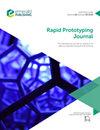Multidisciplinary topology and material optimization approach for developing patient-specific limb orthosis using 3D printing
IF 3.6
4区 工程技术
Q1 ENGINEERING, MECHANICAL
引用次数: 1
Abstract
Purpose This study aims to explore the potential benefits favoring the adaptation of structural optimization techniques in the additive manufacturing (AM) of medical utilities to meet the repetitive demand for functionally precise customized orthoses. Irregularities encountered during the conventional treatment of tendon injuries can be eschewed using advanced structural simulation in design and innovative splint fabrication using 3D printing. Design/methodology/approach A customized mallet finger splint designed from 3D scans was subjected to ANSYS topological simulation comprising multi-level weight reduction to retain optimal mass (100%, 90%, 80%, 70% and 60%). A batch of the four typical 3D printing materials was chosen to conduct a comparative mechanical and thermal stress analysis, facilitating the selection of the optimal one for fabricating functionally adaptive splints. Assurance of structural safety was accomplished through the experimental validation of simulation results against the testing data set of ASTM D695 and ASTM D638 Type-1 specimens over a universal testing machine (UTM). Fused deposition modeling (FDM) 3D printing processed the optimized splint fabrication to assist evaluation of weight reduction percentage, fitting aesthetics, appearance, comfort, practicality and ventilation ease at the user end. Findings AM efficacy can efficiently execute the design complexity involved in the topology optimization (TO) results and introduces rehabilitation practicality into the application. Topologically optimized splint provided with favorable comfort, stiffness and strengthening features, offers ventilation ease and structural stability for customized appliances, with 30.52% lighter weight and 121.37% faster heat dissipation than unoptimized one. Originality/value The state of art multidisciplinary optimization featured with structural and material optimization attributes can deliberately meet medical necessity for performance-oriented orthotic devices.多学科拓扑和材料优化方法开发患者专用肢体矫形器使用3D打印
本研究旨在探讨结构优化技术在增材制造(AM)中的潜在优势,以满足对功能精确定制矫形器的重复需求。利用先进的结构模拟设计和创新的3D打印夹板制造技术,可以避免传统治疗肌腱损伤过程中遇到的不规则现象。设计/方法/方法根据3D扫描设计的定制锤状手指夹板进行ANSYS拓扑模拟,包括多级减重以保持最佳质量(100%,90%,80%,70%和60%)。选择四种典型的3D打印材料进行力学和热应力对比分析,以便选择最优材料制造功能自适应夹板。通过在通用试验机(UTM)上对ASTM D695和ASTM D638 Type-1试件测试数据集的模拟结果进行实验验证,实现了结构安全性的保证。熔融沉积建模(FDM) 3D打印处理优化的夹板制造,以帮助评估重量减轻百分比,贴合美学,外观,舒适性,实用性和用户端的通风便利性。寻找sam效能可以有效地执行拓扑优化(TO)结果中涉及的设计复杂性,并将康复实用性引入应用中。拓扑优化后的夹板具有良好的舒适性、刚度和加强特性,为定制器具提供了通风便利性和结构稳定性,比未优化的夹板重量减轻30.52%,散热速度加快121.37%。具有结构和材料优化属性的多学科优化技术,可以刻意满足医疗对性能导向矫形器的需求。
本文章由计算机程序翻译,如有差异,请以英文原文为准。
求助全文
约1分钟内获得全文
求助全文
来源期刊

Rapid Prototyping Journal
工程技术-材料科学:综合
CiteScore
8.30
自引率
10.30%
发文量
137
审稿时长
4.6 months
期刊介绍:
Rapid Prototyping Journal concentrates on development in a manufacturing environment but covers applications in other areas, such as medicine and construction. All papers published in this field are scattered over a wide range of international publications, none of which actually specializes in this particular discipline, this journal is a vital resource for anyone involved in additive manufacturing. It draws together important refereed papers on all aspects of AM from distinguished sources all over the world, to give a truly international perspective on this dynamic and exciting area.
-Benchmarking – certification and qualification in AM-
Mass customisation in AM-
Design for AM-
Materials aspects-
Reviews of processes/applications-
CAD and other software aspects-
Enhancement of existing processes-
Integration with design process-
Management implications-
New AM processes-
Novel applications of AM parts-
AM for tooling-
Medical applications-
Reverse engineering in relation to AM-
Additive & Subtractive hybrid manufacturing-
Industrialisation
 求助内容:
求助内容: 应助结果提醒方式:
应助结果提醒方式:


